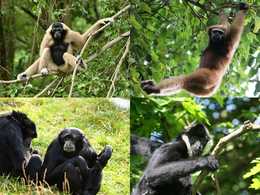China Event Raises Concern Over India’s Only Ape
Context:
At a recent international conference on gibbons held in China, the conservation status of India’s sole ape raised questions.
What do we know about hoolock gibbon?
- There are two types of Hoolock Gibbon which are seen in parts of North Eastern India and Parts of China
- Eastern Hoolock Gibbon (Hoolock leuconedys):
- Eastern Hoolock Gibbons are mostly found in Myanmar and southwest Yunnan, China, east of the Chindwin River.
- The colour of the fur is mostly black.
- Genetic study shows a split from a Western Hoolock Gibbon common ancestor around 1.42 million years ago.
- distinct white eyebrows that are separated slightly more widely than those of a Western Hoolock gibbon.
- Western Hoolock Gibbon: Hoolock hoolock, also known as the Western Hoolock Gibbon, is mostly found in Myanmar west of the Chindwin River.
- Light brown or reddish brown is the colour of the fur.
- Genetic research suggests that the Eastern Hoolock Gibbon and humans diverged from one another roughly 1.42 million years ago.
- distinctive white eyebrows that are more closely spaced than those of an Eastern Hoolock gibbon.
What are the threats faced by the Hoolock gibbons (both species)?
- Habitat encroachment: Human activities including farming, building infrastructure, and towns that invade gibbon habitats.
- Fragmentation of the forest restricts the movement and availability of gibbons by dividing their habitats into smaller, isolated sections.
- Gibbons are hunted for their meat, which is used as bushmeat, and for their various body parts, which are utilised in traditional medicine.
- Pet trade: Gibbons are frequently taken in violation of the law and marketed as exotic pets.
What is the strength of these species and their conservative status?
- In the last few decades, there has been a sharp drop in the population of the Eastern Hoolock Gibbon.
- It was one of the top 25 most endangered primates in the world in 2009.
- The likelihood of the Western Hoolock Gibbon surviving is decreasing as a result of habitat loss.
- The International Union for Conservation of Nature (IUCN) Red List classifies it as Endangered.
- Both species are recognized in India under Schedule 1 of the Indian (Wildlife) Protection Act of 1972.
- The largest remaining population of Hoolock Gibbons is determined to be in Myanmar, according to a national Hoolock Gibbon status evaluation done in Myanmar between 2007 and 2011.
- Hunting and logging were shown to be two major threats to both species.
- The two main challenges to their survival were identified as habitat degradation and fragmentation.





